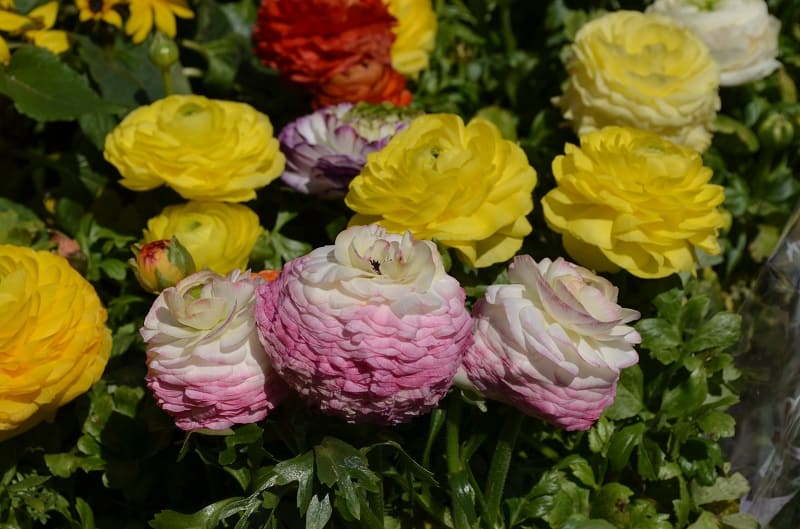
Ranunculus plants are also called buttercups, spearworts and water crowfoots, and comprise a large genus of 600 species of flowering plants. These perennials usually bloom in spring, but their flowers may appear throughout the summer. They are native to Europe and commonly found in gardens, lawns and fields in North America. Their flowers can be red, pink, orange or yellow, and resemble origami flowers. Like most plants, they can sometimes suffer conditions that cause yellowing leaves.
Ranunculus Leaves Turning Yellow: Common Reasons
It could be due to waterlogged soil and crown rot/root rot as a result of overwatering.
Ranunculus plants manifest yellow leaves and become wilted when they are overwatered, due to the waterlogged soil. The roots cannot absorb oxygen and nutrients properly if the soil is waterlogged, and this eventually results in wilting and yellowing of the leaves. The roots become rotten and crown rot and/or root rot may develop.
Crown rot and root rot are diseases caused by fungal pathogens; crown rot may also develop during hot and humid climatic conditions. One of the symptoms is yellowing leaves, which eventually turn brown. Avoid watering your plants if it has rained recently, and always try to check the soil’s moisture with a moisture meter or with your fingers.
Treatment for crown rot and root rot:
- Drench the soil with Captan pesticide, at a measurement of at least two tablespoons to one gallon of water. Do this at least once a month to treat the disease.
- If the disease is already severe and has progressed, discard the affected plants and sterilize the soil around them.
How to prevent crown rot and root rot:
- Check the soil with your fingers and only water your plants if the top inch of soil is dry.
- If your garden soil is heavy or clumpy, mix in some perlite to increase soil drainage.
- Opt for well-draining soil and use pots with drainage holes, so that excess water can drain out properly.
It could be due to insufficient light.
Ranunculus leaves could turn yellow due to insufficient sunlight, since most plants need bright sunlight to bloom and grow. See to it that your plants get full sunlight if they are planted outdoors and, if grown indoors, they should be exposed to direct sunlight for about six hours daily. Indoor ranunculus plants should be kept in temperatures not above 60 degrees Fahrenheit.
It could be due to nitrogen deficiency.
Nitrogen-deficient soil could also result in yellowing leaves, although in this case the newer leaf growth is often greener. Apply Miracle Gro on the soil, as this works well for ranunculus plants. It also has high phosphorus levels that are ideal for blooms. Ideally, you should also conduct a soil test to determine the exact levels of nutrients in the soil.
It could be due to powdery mildew.
Yellowing ranunculus leaves could also be due to powdery mildew. This fungal disease can develop if the leaves are moist most of the time, as moist areas are a perfect habitat for fungal spores. This fungal disease is often characterized by white layers on the upper sides of the infected leaves and fungal outgrowths on the lower sides. Symptoms develop initially on the undersides of the leaves.
Treatment for powdery mildew:
- Fungicides that contain sulfur.
- Baking soda mixed with water and detergent.
- Pruning the infected leaves with sterilized pruning shears.
It could be the plant’s natural life cycle.
Yellowing leaves on ranunculus plants may just be part of the natural life cycle once they are finished blooming. This is nothing to worry about, and you should not prune the plants as it may cause stress. When the leaves have turned completely yellow, you can prune them during the fall season, pruning near the base area to promote blooming in the next season.
It could be due to pests.
Ranunculus plants are also prone to pests like aphids. These attack the plants and suck the sap, or juice, from the plant tissue. They also excrete a sticky fluid called honeydew that attracts a fungus known as black sooty mold.
To get rid of these pests, spray a strong stream of water on the affected leaves and stems. You can also use insecticidal soaps or spray neem oil on the affected branches.
Conclusion
Ranunculus plants are also popularly called buttercups, and are famous for their colorful flowers that resemble origami flowers. They are also prone to problems and conditions that cause yellowing leaves, including overwatering, fungal diseases, nutrient deficiency, insufficient light and pests such as aphids.
Image: istockphoto.com / Cristina Ionescu